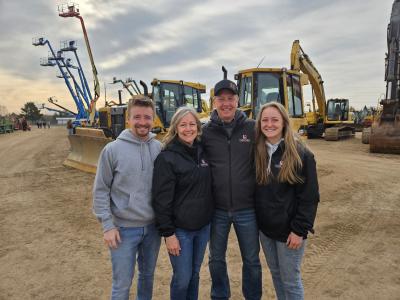Defense of Greater New Orleans’s most vulnerable area from storm surge began April 3, 2008, with the start of the Inner Harbor Navigation Canal (IHNC) Lake Borgne Surge Barrier Project. The project is slated to cost around $700 million and is the largest design-build civil works project in Corps history.
The surge barrier was authorized by Congress in 2006, the year after hurricanes Katrina and Rita devastated the area, and it seeks to reduce the risk of storm damage to some of the region’s most vulnerable areas such as New Orleans East, Metro New Orleans, the Lower Ninth Ward and St. Bernard Parish.
The owners of the project are the U.S. Army Corps of Engineers and Coastal Protection and Restoration Authority of Louisiana. The general contractor is Shaw Environmental & Infrastructure and the principal designer is California-based engineering company Ben C. Gerwick Inc.
Construction started on Dec. 4, 2008. According to Randy Cephus, public affairs officer of the Hurricane Protection Office (the branch in charge of the IHNC project) in New Orleans, most of the work thus far has been dredging out the 2.5-mi. (4 km) area where the barrier will be constructed and conducting pile testing. This month the project should be at a point to begin construction of the barrier, as many of the piles were fabricated off site and will be barged into the construction area.
According to Lt. Col. Vic Zillmer, IHNC surge barrier project resident engineer, the project is an opportunity to expand knowledge of what is possible in the realm of engineering.
“From a historic standpoint, while the Greeks, Romans, Carthaginians and even King Herod of Judea all built harbors and port facilities thousands of years ago, none of them ever tried to build one with gates 26 feet tall, designed to keep out hurricanes,” said Zillmer. “To my knowledge, even the Dutch efforts, which are a standard by which the world measures, have never had to deal with wave forces the size and intensity we are building for.”
The project is a major piece of the Hurricane and Storm Damage Risk Reduction System, a project the Army Corps of Engineers set to provide a 100-year level of risk reduction for southeast Louisiana in 2011. The system will upgrade existing flood protection features such as floodwalls and levees. It also will introduce new features needed to complete the system and authorized by Congress.
Another aspect of the project is the speed of both the design and construction. It is highly unusual for a civil works project to be designed and constructed simultaneously but the route is necessary given the compressed timeframe to have the system in place by the targeted 2011 hurricane season.
“We are shrinking what would normally be a ten to fifteen year design effort into one year and at the same time a normal construction effort from five or ten years down to 2.5 years,” said Zillmer. “This will require us to build the structure in the path of the hurricanes during hurricane seasons.”
The barrier is being built to block the powerful Gulf of Mexico storm surge from entering the Gulf Intracoastal Waterway (GIWW). When completed, the barrier will extend from the Michoud Canal floodwall along the GIWW to the Mississippi River Gulf Outlet (MRGO) levee just south of the Bayou Bienvenue control structure. The barrier will close two large waterways — the Gulf Intracoastal Waterway and the Mississippi River Gulf Outlet.
Zillmer said probably the greatest challenge is to get every member of the team; local, state, Corps of Engineers, other federal agencies, industrial partners, and citizens living in the affected areas, to understand both the complexity of the project, secondary impacts of decisions, and the extremely short time frame they have to work with.
“We just don’t have time for one more study, one more investigation, or to consider one more course of action,” said Zillmer. “Every day that passes is one day less before the next hurricane arrives and therefore each day must be invested wisely.”
The Corps also is faced with overcoming challenges such as working in poor soil conditions and protecting workforce and equipment should a hurricane approach this year.
Zillmer said around 50 years ago engineers were faced with similar problems when building the 20-plus mi. (32 km) long causeway bridge across Lake Ponchartrain. “Their solution was very similar to ours,” he said.
Zillmer said they solved the poor soil-bearing strength by dredging a canal and working by barge. Then, like now, they used post-tensioned spun-cast piles and constructed most of the components on land and then moved those components by barge for final assembly over water.
“Julius Caesar did much the same thing when he built a timber bridge across the Rhine River in a week, more than two thousand years ago,” he said.
Construction for the project is 100 percent federally funded. The state of Louisiana also is involved in the project’s development and completion. The Corps also is collaborating with external stakeholders including the Southeast Louisiana Flood Protection Authority East, the U.S. Coast Guard and the navigation industry.
According to the Army Corps of Engineers, the project consists of about 2 mi. (3.2 km) of risk reduction barrier near Lake Borgne — two sector gates, a barge swing gate, T-wall, and pile supported floodwall. The barrier will be 24 to 26 ft. (7.3 to 7.9 m) high and is designed to reduce the risk of flooding from a storm with a 1 percent chance of occurring in any given year. The Lake Borgne barrier and the barrier at Lake Pontchartrain (Seabrook) operate as a system to protect the communities surrounding the Inner Harbor Navigation Canal. Advance measures, set to be completed by 2009, include the concrete barrier and a swinging navigation gate on the GIWW that would allow navigation to bypass the construction of the concrete floodwall and at the same time provide protection from surges. Additionally, cofferdams (temporary retaining structures) would be built at both the GIWW bypass swing gate and the location of the Bayou Bienvenue gate to provide risk reduction until the gates are complete. A second level of risk reduction is achieved by installing the concrete caps on top of the concrete barrier. Advance measures will be up to an elevation of 14 to 20 ft. (4.3 to 6 m).
Zillmer said they have been, or will be, building components, 66-in. (168 cm) spun-cast concrete piles, 36-in. (91 cm) pipe piles, 18-, 24- and 36-in. (46, 61 and 91 cm) square concrete piles and deck sections off-site where they will be towed to site and assembled as needed. The assembly will be a 24/7 operation, to provide as much protection for the city as possible, as soon as possible.
Hurricanes are another issue.
“We expect to have around 45 crane barges and over 100 supply barges in the area during hurricane season,” said Zillmer. “We will be working with the Coast Guard to find a way to evacuate the fleet of barges to a safe haven along with all the other traffic on the canals.”
According to Zillmer every decision must be considered from the second and third order effects on cost and time.
“As on so many projects, a simple fix for one problem can cause unforeseen impacts on other aspects of the project,” he said. “We constantly strive to have designers, construction managers, and cost account managers at the same meetings at the same time so we can avoid stove pipe solutions that can have dramatic cost, design, or schedule impacts. Generally we have been successful, but often the conversations can become quite animated.”
So far, pile load tests are 30 percent complete and final designs are in various stages with overall design about 50 percent complete. Most of the project is constructed off site at various yards and final assembly of the components is done by barge onsite. According to the Corps, peak construction employment, including both onsite and offsite, is estimated at around 2,000 people.
“We are working hard every day to get advance measures in place by this hurricane season and to complete the project by the 2011 hurricane season,” said Zillmer. ”We cannot do this alone and it will take the combined efforts of the federal, state and local partners to achieve this goal.”
Today's top stories















